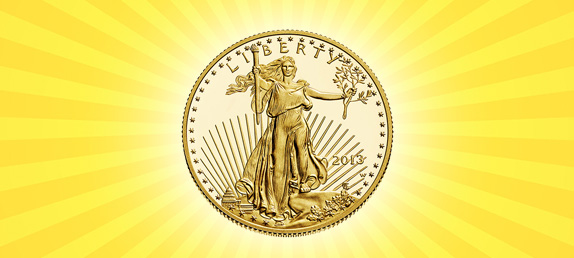
Financial news has been flooded with stories about the price of gold. In the fall of 2011 gold prices peaked at almost $1,900 an ounce and held in this area until October 2012. Since then the price of gold has plummeted, even dropping below $1,200 an ounce. In the last month, prices have begun to climb again, finally getting up past $1,300. So what is it about this yellow metal that has captured the investment world’s attention?
A lot of financial advisors and analysts, including CNBC’s Jim Cramer, recommend owning gold as portfolio insurance against a declining U.S. dollar and inflation. Most of the time, gold has an inverse relationship to currency prices. As currencies go down, gold prices go up. In the last year, despite the economic stimulus, the U.S. dollar has remained strong due to other currencies, like the Yen, doing even worse. The strong dollar in the face of a declining economy was one of the factors leading to a drop in gold prices. But world governments are showing no signs of slowing the stimulus anytime soon which should eventually lead to a drop in the value of the U.S. dollar.
Gold is also a good risk diversifier because it seemingly has no correlation with other assets. To say this in another way, gold prices do not move in line with the value of bonds, real estate, stocks, and other common investments.
In the current world of economic stimulus and volatile markets, it is easy to see why gold is making news. Last week, Tom Stevenson, a Fidelity asset manager, said of the climbing gold prices: “Gold received a boost after a Bank of Japan board member hinted at further monetary stimulus. Gold tends to rise when worries about excessive stimulus increase.”
Marcus Grubb, managing director of investment at the World Gold Council in London, said, “Unless you believe that the global economy is heading for a strong and sustained recovery where central banks will allow interest rates to rise above inflation, you’d have to conclude that the bearishness we have seen is excessive. The reality is that central banks have little choice but to keep interest rates very low to stimulate growth. And inflation is likely to be maintained at higher levels, with currencies like sterling remaining weak. We might have talk of ‘tapering,’ or anxiety about the beginning of the end of quantitative easing, but in reality the Fed and the Bank of England will have to keep applying stimulus for several years. We will go into a phase where we will see an on-off approach to managing the economy. And that will be very supportive to the price of gold.”
While some experts remain bearish on the price of gold, very few are arguing that there is further to drop. Instead, most analysts agree with Mr. Grubb and feel that the bottom has been reached and that gold prices are on their way back up. How quickly they will surge remains to be seen, but a few people, including former congressman Ron Paul, think that when the gold price surge happens it will be “an explosion.”

